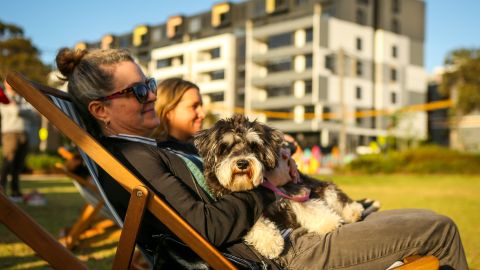The survey is a broad-ranging health check of social, cultural and environmental factors that affect quality of life.
Only 12% of residents were neutral towards their life overall and 9% were unsatisfied or very unsatisfied.
Families with children, couples, home owners (to be) and full-time workers rated different aspects of their life and their life overall higher than others.
Personal wellbeing scores also increased with age. People aged over 70 and retirees were among the groups most satisfied with their life.
In contrast, personal wellbeing and components of quality of life in general were rated lower by people with disability, public or community housing tenants, Aboriginal and Torres Strait Islander peoples, and people living alone or in group households.
At home and surrounds
Across the 7 areas of personal wellbeing the survey captured, people living in the city were the most satisfied with their standard of living, with 81% satisfied or very satisfied. 80% of residents were also satisfied with safety.
When asked which features are the most important in deciding to live in their area, being close to transport (78%), workplace or study (70%), parks and greenery (63%) and places to socialise (64%) were mentioned most often.
About 9 in 10 were satisfied with access to parks and open space in the local area. Green Square Library’s opening improved library access satisfaction in the neighbourhood from 55% in 2015 to 80% in 2018.
Community participation
Our residents keep active. 7 in 10 participated in decision making or civic engagement and 4 in 10 volunteered at least once in the past year. 9 in 10 enjoyed cultural activities and nearly half attended or participated in sports competitions in the past 12 months.
At the same time, 85% of residents reported barriers to community or cultural participation. Lack of time, cost and perceived shortage of suitable or interesting activities were mentioned most often.
Cost of living
While 81% of residents are happy with their standard of living, around half are unsatisfied with the cost of accommodation in their neighbourhood.
6 in 10 students and 16 to 29 year-olds said they had to sacrifice spending on other things or activities due to high housing costs. People with disability were impacted nearly as often. Home buying and rent prices are the top reasons for residents planning to move out of the area.
In more severe cases of financial hardship, residents had run out of food and couldn’t afford to buy more, impacting 8% of the respondents at any point in the past year. The risk of food insecurity is highest among people with disability, public or community housing tenants and Aboriginal and Torres Strait Islander peoples.
Social cohesion
Interaction among the City’s residents can be infrequent. Only half have face to face contact with other people in their area at least weekly, with as many not confident that neighbourly help is available when required. Social isolation and barriers to participate in public life are experienced more often by people living with disability, culturally and linguistically diverse people and younger age groups.
At the same time, 95% of residents are willing to help neighbours, 90% appreciate a diverse society and levels of trust are high. 72% agree that most people can be trusted, indicating that residents support a strong and connected community.
View more information about the 2018 wellbeing survey.
Published 12 November 2019


